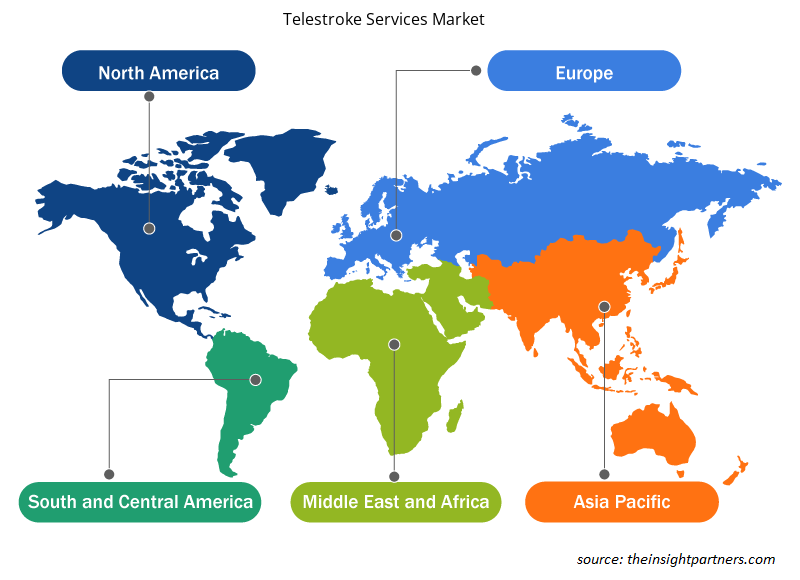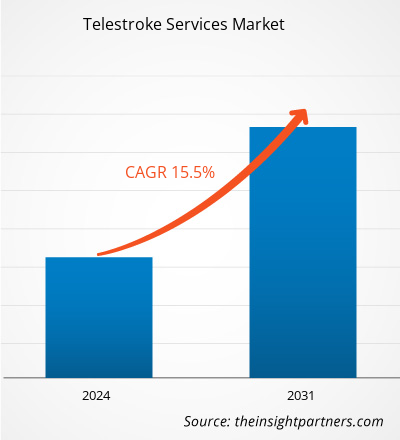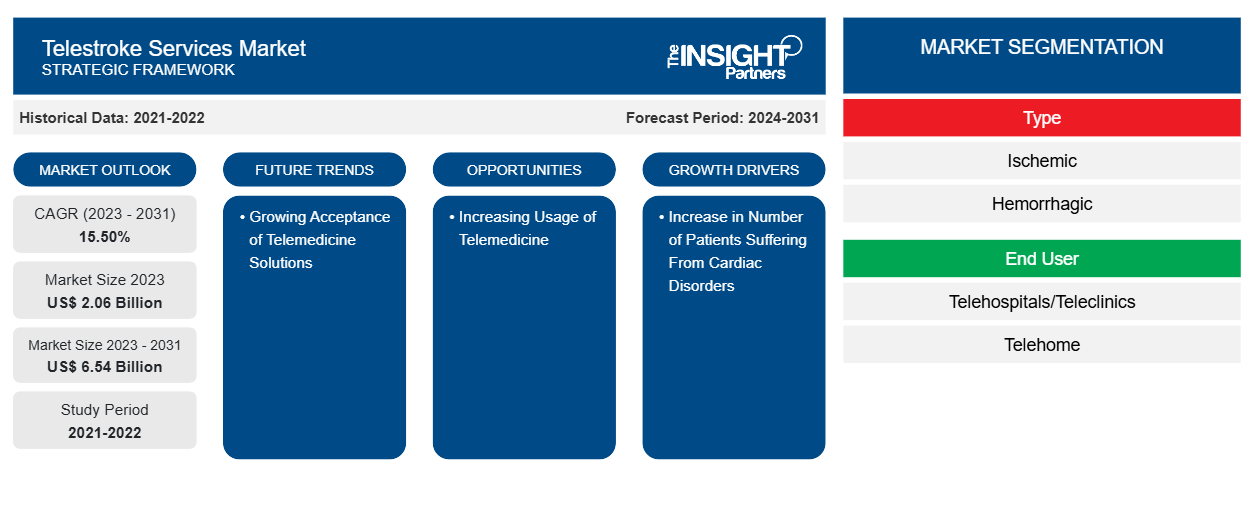Se proyecta que el tamaño del mercado de servicios de teleasistencia médica para accidentes cerebrovasculares alcance los 6.540 millones de dólares estadounidenses en 2031, frente a los 2.060 millones de dólares estadounidenses en 2023. Se espera que el mercado registre una CAGR del 15,50 % durante el período 2023-2031.La aparición de productos tecnológicamente avanzados probablemente seguirá siendo una tendencia clave en el mercado.
Análisis del mercado de servicios de teleasistencia a accidentes cerebrovasculares Services Market Analysis
El mercado se está expandiendo como resultado tanto del número de pacientes cardiovasculares que abandonan el hospital como de la creciente incidencia mundial de casos de ACV. Se espera que el mercado crezca debido a la creciente incidencia de enfermedades cardiovasculares y ACV y al creciente uso de la telemedicina, la tecnología de vanguardia y los servicios de teleasistencia para ACV. Se espera que las políticas de reembolso favorables y una alta tasa de adopción de servicios de teleasistencia para ACV impulsen el mercado de servicios de teleasistencia para ACV. Se prevé que la región de Asia Pacífico crezca en exceso debido al aumento de los lanzamientos de productos, la mejora de la infraestructura sanitaria y los avances tecnológicos.
Descripción general del mercado de servicios de teleasistencia para accidentes cerebrovasculares
Una de las principales causas de muerte y discapacidad en el mundo es el accidente cerebrovascular. Según la Organización Mundial de la Salud (OMS) en 2016, el accidente cerebrovascular fue la segunda causa de muerte más común. El accidente cerebrovascular es un problema de salud pública importante que perjudica a la sociedad y la economía. En las próximas décadas, la carga de accidentes cerebrovasculares en la salud pública aumentará como resultado de los cambios demográficos, especialmente en los países en desarrollo. Por lo tanto, el creciente número de casos de accidente cerebrovascular aumentará la aceptación de las soluciones de telemedicina, impulsando así el crecimiento del mercado.
Personalice este informe según sus necesidades
Obtendrá personalización en cualquier informe, sin cargo, incluidas partes de este informe o análisis a nivel de país, paquete de datos de Excel, así como también grandes ofertas y descuentos para empresas emergentes y universidades.
-
Obtenga las principales tendencias clave del mercado de este informe.Esta muestra GRATUITA incluirá análisis de datos, desde tendencias del mercado hasta estimaciones y pronósticos.
Impulsores y oportunidades del mercado de servicios de teleasistencia para accidentes cerebrovasculares
El aumento del número de pacientes con trastornos cardíacos favorece el crecimiento del mercado
A nivel mundial, las enfermedades cardiovasculares (ECV) se encuentran entre las principales causas de muerte. La Organización Mundial de la Salud estima que en 2019 hubo 17,9 millones de muertes en todo el mundo relacionadas con ECV, es decir, el 32 % de todas las muertes. Además, los ataques cardíacos y los accidentes cerebrovasculares fueron la causa del 85 % de estas muertes. Los países de ingresos bajos y medios representan al menos el 75 % de las muertes relacionadas con enfermedades cardiovasculares en todo el mundo.
Además, en comparación con la población general, los pacientes cardíacos tienen un riesgo notablemente mayor de enfermedad cardíaca y accidente cerebrovascular. Se cree que el factor de riesgo predisponente más importante para el accidente cerebrovascular isquémico agudo (AIS) es la ECV. En pacientes con enfermedad de la arteria coronaria , la aparición de AIS se duplica, y en pacientes con fibrilación auricular, se multiplica por cinco. Además, los pacientes con accidente cerebrovascular son particularmente susceptibles a eventos adversos cardíacos graves porque el daño cerebral puede cambiar las vías autónomas y neurohormonales que regulan la función cardíaca. Específicamente, la autorregulación cerebral puede verse comprometida por AIS, lo que resulta en que el flujo sanguíneo cerebral dependa de la función cardíaca. Los médicos especializados en cardiología y accidentes cerebrovasculares trabajan en estrecha colaboración con socios de la industria para desarrollar herramientas, recursos y tratamientos que puedan ayudar a reducir los tiempos de tratamiento y mejorar la eficiencia. El mercado está creciendo debido a la mayor demanda y aceptación de los servicios de teleictus provocados por la mayor frecuencia de estos casos de ECV.CVD. In patients with fivefold. Furthermore, stroke patients are particularly susceptible to severe cardiac adverse events because brain damage can change the autonomic and neurohormonal pathways that regulate heart function. Specifically, cerebral autoregulation may be compromised by AIS, resulting in cerebral blood flow being reliant on heart function. Physicians specializing in cardiology and stroke work closely with industry partners to develop tools, resources, and treatments that can help reduce treatment times and improve efficiency. The market is growing due to the augmented demand and uptake of telestroke services brought on by the increased frequency of these CVD cases.
Aumento del uso de la telemedicina
Los servicios médicos atienden enfermedades y problemas clínicos complejos de manera eficiente y rápida. Sin embargo, a medida que la población envejece y aumenta la prevalencia de enfermedades crónicas, existe una creciente necesidad de servicios médicos, lo que aumenta los costos y ejerce presión sobre los sistemas de atención médica . Durante más de treinta años, los profesionales de la salud han utilizado la telemedicina para tratar a las víctimas de accidentes cerebrovasculares. La tecnología comenzó como una plataforma audiovisual que permitía a los neurólogos observar a un paciente que presentaba síntomas de accidente cerebrovascular. Los servicios de teleictus, que utilizan canales de atención médica conectados para aumentar el diagnóstico y el tratamiento de las víctimas de accidentes cerebrovasculares, están ayudando a los sistemas de atención médica de todo el mundo a salvar vidas. La Ley de Fomento del Acceso a la Telemedicina para Accidentes Cerebrovasculares (FAST) fue parte de la Ley de Creación de Resultados y Resultados de Alta Calidad Necesarios para Mejorar la Atención Crónica (CHRONIC) de 2017. Con el levantamiento de las restricciones rurales y la expansión del seguro médico hospitalario para cubrir los servicios de teleictus a partir de 2021, esta ley puede permitir que más pacientes con accidentes cerebrovasculares reciban servicios de telesalud. Por lo tanto, se anticipa que el mercado de servicios de teleictus presentará oportunidades en los próximos años debido a los factores anteriores.
Análisis de segmentación del informe de mercado de servicios de teleictus Services Market Report Segmentation Analysis
Los segmentos clave que contribuyeron a la derivación del análisis del mercado de servicios de teleictus son el tipo y el usuario final.
- Según el tipo, el mercado de servicios de teleasistencia para accidentes cerebrovasculares se divide en isquémico y hemorrágico. El segmento isquémico tuvo la participación de mercado más importante en 2023.
- Por usuario final, el mercado está segmentado en telehospitales/teleclínicas, teledomiciliarios y otros. El segmento de telehospitales/teleclínicas tuvo la mayor participación del mercado en 2023.
Análisis de la cuota de mercado de los servicios de teleasistencia para accidentes cerebrovasculares por geografía
El alcance geográfico del informe del mercado de servicios de telestroke se divide principalmente en cinco regiones: América del Norte, Asia Pacífico, Europa, Medio Oriente y África, y América del Sur y Central.
Debido a la presencia de importantes actores del mercado, el crecimiento de los sectores de atención médica e investigación en la región y otros factores, se proyecta que el mercado de servicios de telemedicina en la región experimentará un crecimiento significativo durante el período de pronóstico. Además, la creciente conciencia de la región sobre la telemedicina, mejores instalaciones de atención médica y pautas de reembolso adecuadas están impulsando la demanda de servicios de telemedicina en América del Norte. La región de Asia y el Pacífico tendrá abundantes oportunidades de crecimiento durante el período de pronóstico debido al aumento de las inversiones, los avances tecnológicos y un aumento en los lanzamientos de nuevos productos.
Perspectivas regionales del mercado de servicios de teleasistencia para accidentes cerebrovasculares
Los analistas de Insight Partners explicaron en detalle las tendencias y los factores regionales que influyen en el mercado de servicios de teleapoplejía durante el período de pronóstico. Esta sección también analiza los segmentos y la geografía del mercado de servicios de teleapoplejía en América del Norte, Europa, Asia Pacífico, Oriente Medio y África, y América del Sur y Central.

- Obtenga datos regionales específicos para el mercado de servicios de teleasistencia a accidentes cerebrovasculares
Alcance del informe sobre el mercado de servicios de teleasistencia para accidentes cerebrovasculares
| Atributo del informe | Detalles |
|---|---|
| Tamaño del mercado en 2023 | US$ 2.06 mil millones |
| Tamaño del mercado en 2031 | 6.540 millones de dólares estadounidenses |
| CAGR global (2023 - 2031) | 15,50% |
| Datos históricos | 2021-2022 |
| Período de pronóstico | 2024-2031 |
| Segmentos cubiertos |
Por tipo
|
| Regiones y países cubiertos |
América del norte
|
| Líderes del mercado y perfiles de empresas clave |
|
Densidad de actores del mercado: comprensión de su impacto en la dinámica empresarial
El mercado de servicios de teleasistencia para accidentes cerebrovasculares está creciendo rápidamente, impulsado por la creciente demanda de los usuarios finales debido a factores como la evolución de las preferencias de los consumidores, los avances tecnológicos y una mayor conciencia de los beneficios del producto. A medida que aumenta la demanda, las empresas amplían sus ofertas, innovan para satisfacer las necesidades de los consumidores y aprovechan las tendencias emergentes, lo que impulsa aún más el crecimiento del mercado.
La densidad de actores del mercado se refiere a la distribución de las empresas o firmas que operan dentro de un mercado o industria en particular. Indica cuántos competidores (actores del mercado) están presentes en un espacio de mercado determinado en relación con su tamaño o valor total de mercado.
Las principales empresas que operan en el mercado de servicios de teleictus son:
- Salud y servicios de Providence
- Socios del Centro de Teleictus
- Universidad Médica de Carolina del Sur
- Sistema de salud de Granville
- Sistema de salud de Lakewood
Descargo de responsabilidad : Las empresas enumeradas anteriormente no están clasificadas en ningún orden particular.

- Obtenga una descripción general de los actores clave del mercado de servicios de teleictus
Noticias y desarrollos recientes del mercado de servicios de teleasistencia para accidentes cerebrovasculares
El mercado de servicios de teleasistencia para accidentes cerebrovasculares se evalúa mediante la recopilación de datos cualitativos y cuantitativos posteriores a la investigación primaria y secundaria, que incluye publicaciones corporativas importantes, datos de asociaciones y bases de datos. A continuación, se enumeran algunos de los avances en el mercado de servicios de teleasistencia para accidentes cerebrovasculares:
- UPMC ha ampliado los servicios de atención especializada para accidentes cerebrovasculares en UPMC Cole al ofrecer servicios de consulta virtual las 24 horas, los 7 días de la semana, los 365 días del año con especialistas en accidentes cerebrovasculares de renombre mundial del UPMC Stroke Institute en UPMC Presbyterian, un centro integral de accidentes cerebrovasculares certificado. (Fuente: UPMC, comunicado de prensa, enero de 2024)
- El Lakewood Ranch Medical Center recibió el premio "Get With The Guidelines-Stroke Gold Plus Quality Achievement" de la American Heart Association/American Stroke Association. El premio reconoce el compromiso del hospital de garantizar que los pacientes con ACV reciban el tratamiento más adecuado de acuerdo con las pautas basadas en investigaciones y reconocidas a nivel nacional, basadas en la evidencia científica más reciente. (Fuente: Lakewood Ranch Medical Center, comunicado de prensa, agosto de 2020)
Cobertura y resultados del informe sobre el mercado de servicios de teleasistencia para accidentes cerebrovasculares
El informe “Tamaño y pronóstico del mercado de servicios de teleictus (2021-2031)” proporciona un análisis detallado del mercado que cubre las siguientes áreas:
- Tamaño del mercado de servicios de teleasistencia a accidentes cerebrovasculares y pronóstico a nivel mundial, regional y nacional para todos los segmentos clave del mercado cubiertos bajo el alcance
- Tendencias del mercado de servicios de teleasistencia para accidentes cerebrovasculares, así como dinámicas del mercado, como impulsores, restricciones y oportunidades clave
- Análisis detallado de las cinco fuerzas de Porter y PEST y FODA
- Análisis del mercado de servicios de teleictus que cubre las tendencias clave del mercado, el marco global y regional, los principales actores, las regulaciones y los desarrollos recientes del mercado.
- Análisis del panorama de la industria y de la competencia que abarca la concentración del mercado, el análisis de mapas de calor, los actores destacados y los desarrollos recientes del mercado de servicios de teleasistencia médica
- Perfiles detallados de empresas
- Análisis histórico (2 años), año base, pronóstico (7 años) con CAGR
- Análisis PEST y FODA
- Tamaño del mercado, valor/volumen: global, regional y nacional
- Industria y panorama competitivo
- Conjunto de datos de Excel
Informes recientes
Testimonios
Razón para comprar
- Toma de decisiones informada
- Comprensión de la dinámica del mercado
- Análisis competitivo
- Información sobre clientes
- Pronósticos del mercado
- Mitigación de riesgos
- Planificación estratégica
- Justificación de la inversión
- Identificación de mercados emergentes
- Mejora de las estrategias de marketing
- Impulso de la eficiencia operativa
- Alineación con las tendencias regulatorias























 Obtenga una muestra gratuita para - Mercado de servicios de teleictus
Obtenga una muestra gratuita para - Mercado de servicios de teleictus